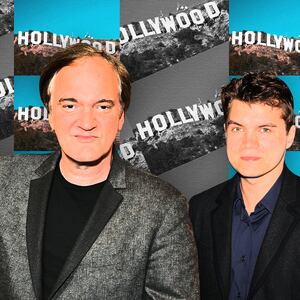Note: This story contains spoilers for Once Upon a Time in Hollywood
Nothing about Once Upon a Time in Hollywood’s fairy-tale ending should go down easy.
The film coils together so many meta layers of reality—from real-world film history, from writer-director Quentin Tarantino’s past and personal foibles, and from our own grim knowledge of what really happened on Cielo Drive on Aug. 9, 1969—that its final minutes become something of a cinematic Rorschach test. How we react to the blood-splattered denouement becomes a matter of who we are, what we’ve experienced, and how we process history.
Do we delight in seeing the Manson kids snuffed out as viciously as the real-life horrors they unleashed on a pregnant woman, three friends, another visitor, and two more people the next night? Do we balk at the knowledge that the “hero” of the scene, stuntman Cliff Booth (Brad Pitt), is a suspected wife-killer? What of the director’s own past transgressions, onscreen and off? And when it’s all over, who deserves redemption? Tarantino leaves these questions unresolved. No wonder reactions to the scene fall all over the map.
Morality in Tarantino movies tends to be expressed Old Testament-style, in which an eye for an eye is the purest way to right past wrongs. And in Westerns, which Tarantino references obsessively in Once Upon a Time, violence is a routine expression of masculinity—just look at Cliff, the movie’s stand-in for a “real” cowboy (versus Rick Dalton, the self-pitying actor who only plays them onscreen), and what’s left of a Manson boy’s face after he leaves Cliff with a flat tire at Spahn ranch and brattily refuses to change it. (Tarantino even gives Cliff’s moccasins a close-up shot reminiscent of a sheriff squaring off against a black hat, an effect heightened by the abandoned Western movie set in the background.)
The movie’s ending combines these impulses, puncturing the dread that’s built with every title card counting down to August 9 with a violent, thrilling reversal of history. Instead of breaking into the actress Sharon Tate’s home, three Manson kids (Tex Watson, Susan Atkins, and Patricia Krenwinkel, played by Austin Butler, Mikey Madison, and Madisen Beaty, respectively) break into Dalton’s house, figuring him a good symbol for the media that “taught” them to kill. Cliff and his darling pit bull Brandy, with an assist from Rick and his old prop flamethrower, savagely tear the Manson kids to ribbons, making them look both delusional (Cliff chuckles when later recalling Tex’s “devil” talk) and wildly incompetent. These were not criminal masterminds—they were drug-addled twentysomethings instructed to murder innocent people by a narcissistic failed rock star who misread some Beatles lyrics and decided to start a race war. Their over-the-top demises are meant as grief- and rage-fueled catharsis—a biblical-level smiting against bad people who deserve it. But not everyone has felt relief.
That two of the would-be Manson murderers were women has provoked consternation, in part because of Tarantino’s history of reveling in onscreen violence and targeting it at women as often as men. Some have argued that those women and their trauma were manipulated by Manson, and that directing rage against them misses the point. It’s a valid reaction, but perhaps one that minimizes those women’s participation in the real-life murders, or worse infantilizes them. Outside of Tarantino’s fantasy, Susan Atkins boasted of stabbing Tate as the eight-and-a-half-month pregnant actress begged for her child’s life. She told people that she tasted Tate’s blood and used it to smear the word “Pig” on the home’s front door. Patricia Krenwinkle testified that she stabbed Abigail Folger, a friend of Tate’s, 28 times. The next night, she stabbed Rosemary LaBianca in Los Feliz as the woman begged them to spare her husband. Tate’s sister, Debra, has expressed gratitude that Tarantino does not glorify her sister’s killers: They “were not hippies…they were people with an agenda for murder,” she told Vanity Fair. “They weren’t there because Charles Manson coerced them or [threatened them]…These people were there by choice.”
But the happy ending is complicated by the Cliff of it all.
For most of the movie, Cliff is depicted as an ineffably cool figure—a bit aimless, but self-possessed, capable, and brave. He is also deceptively dangerous. A flashback to a sparring match with Bruce Lee shows us he can handle himself in a fight. Another flashback (within yet another) dramatizes the rumor that’s gone around town about him, blacklisting him on most sets. He sits on the deck of a yacht as his wife rails at him about the dead-end he’s brought their lives to. She is harsh, insensitive, annoying, not unlike Bridget Fonda’s character in Jackie Brown, Melanie, who is killed for nagging and laughing at a man. But Cliff’s story is left ambiguous. We see his wife stand in front of him, his harpoon gun resting on his lap at a dangerous angle. And then we pull away; the question of whether Cliff killed her that day is never touched on again. Yet Tarantino includes it to color our perception of Cliff with a tinge of darkness—when he sweetly pulls out a six-pack of beer for TV time with his best buddy, we remember it. Ditto when he becomes Rick’s and Sharon’s savior against the Manson “family.”

Brad Pitt stars in Quentin Tarantino's Once Upon a Time in Hollywood
Sony Pictures EntertainmentIt becomes a dilemma familiar from both distant and recent Hollywood—rumors about bad men and the people who enable them, and the way Hollywood overlooks moral inconveniences in the name of carrying on business as usual. Tarantino encourages applying real-world context to what’s going on onscreen throughout the movie; it’s crucial to intensifying the film’s notes of underlying dread as it inches closer to when we expect Tate’s murder, and to the delight of seeing the Mansons’ fortunes so righteously reversed. But it also invites other connotations that complicate that ending further. Tarantino’s recent slew of controversies—the Kill Bill crash, his admitted measure of complicity in Harvey Weinstein’s years of preying on women, his hiring Emile Hirsch despite the actor’s 2015 conviction for violently assaulting a female movie executive at Sundance—might color how you see Rick when he lobbies for Cliff to be hired on The Green Hornet, or what you think really happened on that yacht. What Tarantino said about Samantha Geimer, Roman Polanski’s then 13-year-old rape victim (that she was “down wth it”), might come to mind in a sequence where an underage Manson girl attempts to seduce Cliff. (Tarantino said that in 2003 and has since apologized both personally to Geimer and publicly; Geimer accepted the apology.)
Tarantino seems to partly identify with these middle-aged Hollywood veterans who fear they are being supplanted in a culturally and politically changing world, however vital his movies still turn out to be. (The debate surrounding this one certainly attests to that.) That anxiety perhaps invites us to question who deserves redemption in the film’s final scene. Rick is invited by Hirsch’s character Jay Sebring and Tate into her home. The gates on Cielo Drive swing open, welcoming him into Hollywood heaven, renewed relevance, and the social status he’s always hoped for. Cliff, meanwhile, is sent away in an ambulance. It’s a hopeful, beautiful final image, and a fitting fairy tale ending. But it depends on what we choose to see.


